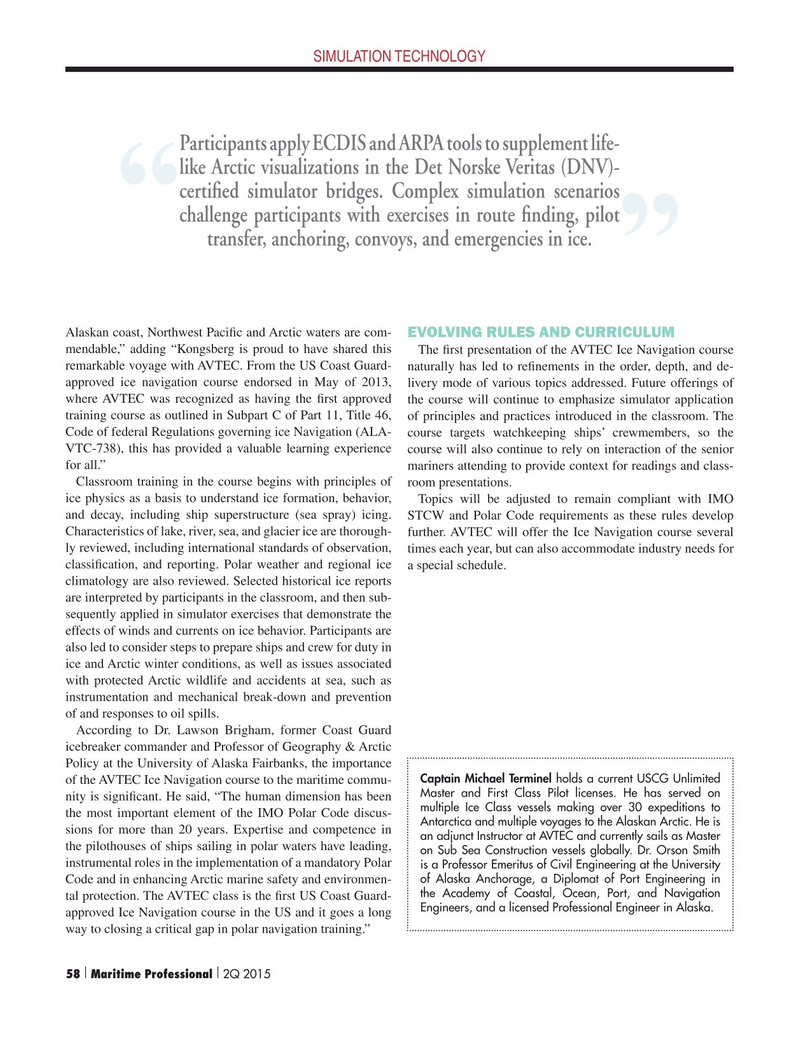
Page 58: of Maritime Logistics Professional Magazine (Q2 2015)
Read this page in Pdf, Flash or Html5 edition of Q2 2015 Maritime Logistics Professional Magazine
SIMULATION TECHNOLOGY
Participants apply ECDIS and ARPA tools to supplement life- like Arctic visualizations in the Det Norske Veritas (DNV)- certi? ed simulator bridges. Complex simulation scenarios challenge participants with exercises in route ? nding, pilot “ transfer, anchoring, convoys, and emergencies in ice.
”
Alaskan coast, Northwest Paci? c and Arctic waters are com-
EVOLVING RULES AND CURRICULUM mendable,” adding “Kongsberg is proud to have shared this The ? rst presentation of the AVTEC Ice Navigation course remarkable voyage with AVTEC. From the US Coast Guard- naturally has led to re? nements in the order, depth, and de- approved ice navigation course endorsed in May of 2013, livery mode of various topics addressed. Future offerings of where AVTEC was recognized as having the ? rst approved the course will continue to emphasize simulator application training course as outlined in Subpart C of Part 11, Title 46, of principles and practices introduced in the classroom. The
Code of federal Regulations governing ice Navigation (ALA- course targets watchkeeping ships’ crewmembers, so the
VTC-738), this has provided a valuable learning experience course will also continue to rely on interaction of the senior for all.” mariners attending to provide context for readings and class-
Classroom training in the course begins with principles of room presentations.
ice physics as a basis to understand ice formation, behavior, Topics will be adjusted to remain compliant with IMO and decay, including ship superstructure (sea spray) icing. STCW and Polar Code requirements as these rules develop
Characteristics of lake, river, sea, and glacier ice are thorough- further. AVTEC will offer the Ice Navigation course several ly reviewed, including international standards of observation, times each year, but can also accommodate industry needs for classi? cation, and reporting. Polar weather and regional ice a special schedule. climatology are also reviewed. Selected historical ice reports are interpreted by participants in the classroom, and then sub- sequently applied in simulator exercises that demonstrate the effects of winds and currents on ice behavior. Participants are also led to consider steps to prepare ships and crew for duty in ice and Arctic winter conditions, as well as issues associated with protected Arctic wildlife and accidents at sea, such as instrumentation and mechanical break-down and prevention of and responses to oil spills.
According to Dr. Lawson Brigham, former Coast Guard icebreaker commander and Professor of Geography & Arctic
Policy at the University of Alaska Fairbanks, the importance
Captain Michael Terminel holds a current USCG Unlimited of the AVTEC Ice Navigation course to the maritime commu-
Master and First Class Pilot licenses. He has served on nity is signi? cant. He said, “The human dimension has been multiple Ice Class vessels making over 30 expeditions to the most important element of the IMO Polar Code discus-
Antarctica and multiple voyages to the Alaskan Arctic. He is sions for more than 20 years. Expertise and competence in an adjunct Instructor at AVTEC and currently sails as Master the pilothouses of ships sailing in polar waters have leading, on Sub Sea Construction vessels globally. Dr. Orson Smith instrumental roles in the implementation of a mandatory Polar is a Professor Emeritus of Civil Engineering at the University of Alaska Anchorage, a Diplomat of Port Engineering in
Code and in enhancing Arctic marine safety and environmen- the Academy of Coastal, Ocean, Port, and Navigation tal protection. The AVTEC class is the ? rst US Coast Guard-
Engineers, and a licensed Professional Engineer in Alaska.
approved Ice Navigation course in the US and it goes a long way to closing a critical gap in polar navigation training.” | | 58 Maritime Professional 2Q 2015

 57
57

 59
59
